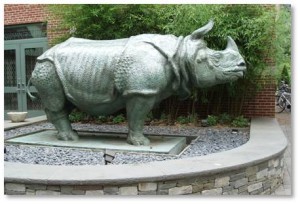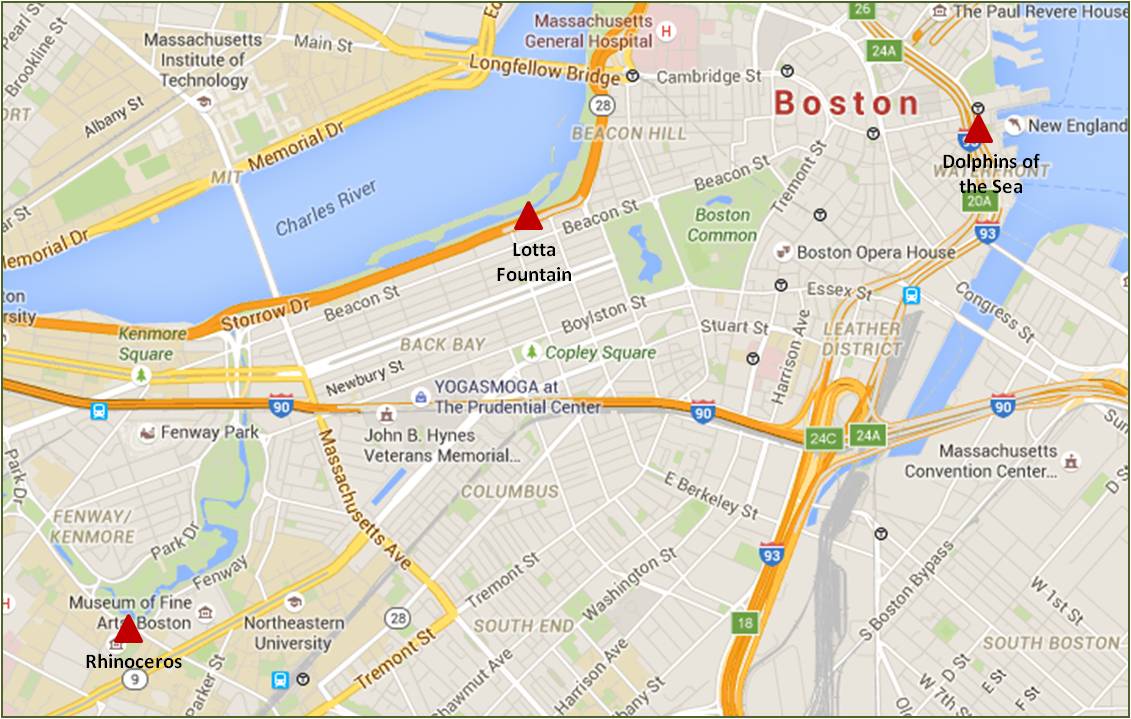Like many cities, Boston is filled with statues and other types of public art. The majority, however, are of what’s been called, “dead white men.” There are a few memorials for women but, surprisingly, there are far more statues of animals. This collection includes animals large and small, wild and domestic, walking and swimming, fierce and friendly. They are scattered all over the city and are fairly easy to find, especially if you know where to look.
A Crash of Rhinoceroses
I thought it would be fun to do a series of posts on Boston’s bronze menagerie and I’m starting big—with the city’s four rhinoceroses. Wait. What? Who knew that there was even one? Well, two of them are technically in Cambridge but the “crash” of rhinos is all connected. Here’s how:
Pedestrians along the Fenway are sometimes surprised to discover a life-sized rhinoceros standing outside the School of the Museum of Fine Arts. The beast is so massive and so imposing that it’s hard to miss. They might wonder how a rhino came to be here in this city of frigid winters.
The Four Bronze Rhinos
The statue was sculpted by Katherine Ward Lane Weems, a Boston native who began her artistic career in the first half of the twentieth century. This was a time when women were often barred from art schools and considered to lack the strength and stamina to sculpt works of any size. Ms. Weems set out to distinguish herself by focusing on a specific niche: statues of animals. She created the four statues of rhinos in the Boston area — along with several other well-known pieces.
Bessie and Victoria, two Indian rhinos, stand outside Harvard University’s Biological Sciences Building, now the department of Molecular and Cellular Biology (MCB). Ms. Weems was commissioned to “embellish” the outside of the building in 1930 by Harvard’s President, A. Lawrence Lowell. Only 30 years old at the time, she created a carved brick frieze of birds around the top of the building and the three main entrance doors that highlight species of animals that live on earth, air and sea.
Rhinoceros Unicornis
Two years later she started work on the massive sculptures that bracket the doors. Ms. Weems based both studies on a living female Rhinoceros unicornis at the Bronx Zoo and worked on them for five years. Each statue was modeled separately and scaled up to match the largest recorded specimen. According to Harvard, Bessie and Victoria are,
“. . . morphologically accurate, weigh three tons apiece, and are among the largest bronze sculptures cast in the twentieth century. They have been, and will likely always be, the building’s most distinctive feature.”
Ms. Lane named the two sculptures after queens of England, possibly because she created them at her studio in Manchester, England, and they were unveiled on May 12, 1937, the coronation day of King George VI.
The rhinoceros at the Museum School is a fiberglass copy of one of Harvard’s beasts, the one that stands on the right. That must be Bessie because that’s what the students @SMFABoston call their beast. The sculpture was placed at the Museum School to commemorate that fact that Katherine Lane studied there from 1918 to 1922 and also to celebrate her place as one of America’s foremost animal sculptors. .
In addition to the three Harvard and Museum School rhinos, Katherine Lane Weems sculpted a black African rhinoceros — also nameless — that stands outside the Museum of Science at 11 Science Park.
Katherine Lane Weems
Katherine Ward Lane was born in Boston as the only child of Gardiner Martin and Emma Louise (Gildersleeve) Lane. She was raised in a beautiful Back Bay house at 53 Marlborough Street that was designed in 1867 by Sturgis and Brigham. (It is currently the French Cultural Center.)
Ms.Lane received the privileged education that was typical for women of her class. Her admission to the Museum School was possibly influenced by the fact that her father became president of the Museum of Fine Arts in 1907, although she was known for not trading on that connection. She married the banker Fontaine Carrington Weems in 1947 and moved with him to New York City.
In addition to hard work, the determination to become an artist, and the fortitude to defy social expectations, she understood the underlying anatomy of the animals she sculpted. Ms. Weems observed live animals to learn their anatomy and behavior. She also studied the artistic treatment of animals in Indian and ancient Egyptian art as well as Japan and China, particularly those in the Han Dynasty tombs.
More Weems Sculptures
Katherine Lane Weems pursued a distinguished career as an animal sculptor and several of her works adorn the streets and buildings of Boston. In addition to the four rhinos, she sculpted the work called “Dolphins of the Sea:” six dolphins leaping outside the New England Aquarium. Children often climb on it and hug the dolphins, which accounts for their shiny backs.
The Lotta Crabtree Fountain on the Charles River Esplanade is also her work and one of the few statues of dogs in the city.
Ms. Weems donated her personal collection of 30 bronze animal sculptures to the Museum of Science, where it forms the largest collection of her works in the world. She died at age 89.
Directions to the Rhinos
Here’s a map of the three Katherine Lane Weems animal statues in Boston. Bessie and Victoria can be found @Harvard University in Cambridge, MA.






Thank you, Aline!
I have referenced and quoted from this and another post of yours about art by Katharine Lane Weems. Your information and context about her work connect wonderfully with the focus in my latest post on Art Outdoors.
https://artoutdl.wordpress.com/2019/08/31/admire-animals-by-artist-katharine-lane-weems-in-boston-dogs-dolphins-rhinos-and-more/
ADMIRE ANIMALS BY ARTIST KATHARINE LANE WEEMS IN BOSTON: DOGS, DOLPHINS, RHINOS AND MORE
Your comments, questions, corrections, connections always welcome!
Many thanks and cheers,
Deb Lee
Deb: I enjoyed reading your post and I’m glad you found my posts on KLW to be helpful. Thank you, also, for the links. I love it when new readers find their way to my blog. Let me know if I can help in any way.
Aline thank you for your article. I am writing a book on “Art and the Rhinoceros” and will definitely include Katherine Lane Weems in my book. I do not have any photos of her sculptures and was wondering if you could email me a slightly higher pixel photo of —Bessie and Victoria flanking the three doors at Harvard’s Mollecular and Cellular Biology building and any other rhino sculpture photos that could be included in my book. Also what information you would like about yourself for copyright purposes of the photos. I am aiming at doing an e-book so photos do not need to be too large. All profits will go to The Rhino Foundation.
Kind regards, Lorraine Fildes Australia. I do not have a website but my husband does.
Lorraine: I have been using photos available on the internet but can take a higher rez photo this weekend. Thank you so much for reading my blog and for offering me a chance to participate in your effort to support The Rhino Foundation.
Lorraine: My husband took pictures of the rhino statues in Boston yesterday. What email address should he send them to?
Aline and Seth thank you for the photos. I am still working on my book – there is just so much information available. I will let you know when I have finished and send you a copy. Lorraine.
Nice piece. I’ve been doing some research on her, whom I remember as “Kay Lane,” when I was younger and living down the road from her Manchester home. She was good friends with my grandfather, the painter Charles Hopkinson. I’ll be giving a talk on her work and his next month. Incidentally, Aline, her middle name was Ward, not Lord.
Thank you for your comment, Tom. I have been away but will make that change today.
She sounds fascinating. Are there any books about her?
Brenda:
Here autbiography is called “The Odds Were Against Me,” and it’s on Amazon at: http://www.amazon.com/Odds-Were-Against-Katherine-Weems/dp/0533062969/ref=sr_1_fkmr0_1?ie=UTF8&qid=1453309556&sr=8-1-fkmr0&keywords=katherine+Lane+Weems
Katherine Lane Weems is also included in “North American Women Artists of the Twentieth Century,” which is available from Amazon at: http://www.amazon.com/North-American-Artists-Twentieth-Century/dp/0815325843
I’m so glad you enjoyed the post about her rhinos.
Aline
Thank you,
I have always loved our school’s mascot; very COOl!